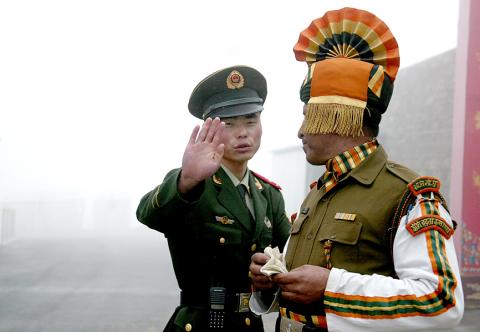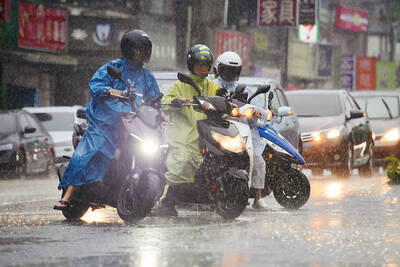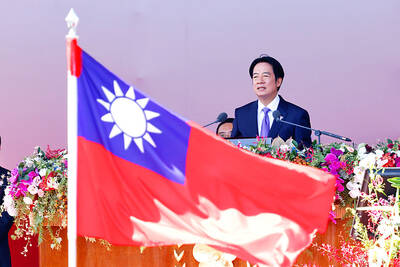China has stepped up its rhetoric in an increasingly tense border row with India, hinting at the possibility of military action in a propaganda push that analysts are calling “genuinely troubling.”
For more than a month, Indian and Chinese troops have been locked in a standoff on a remote, but strategically important Himalayan plateau near where Tibet, India and Bhutan meet.
On Thursday, Chinese Ministry of Defense spokesman Ren Guoqiang (任國強) said that Beijing had shown restraint, but had a “bottom line.”

Photo: AFP
“No country should underestimate the Chinese forces’ ... resolve and willpower to defend national sovereignty,” Ren said in a post on the ministry’s Web site.
It is a line that has been echoed almost word for word this week by the Chinese Ministry of Foreign Affairs, the Xinhua news agency, the Chinese Communist Party mouthpiece the People’s Daily, the official military news Web site of the Chinese armed forces and other outlets.
On Wednesday, the foreign ministry released a 15-page document of “facts” about the border dispute, which included a map of alleged intrusions and photographs of what it stated were Indian troops and military vehicles on China’s side of the border.
Calling for the “immediate and unconditional” withdrawal of Indian troops, it said that Beijing would “take all necessary measures” to safeguard its interests.
Chinese Ministry of Foreign Affairs spokesman Geng Shuang (耿爽) on Thursday said that India was building roads, hoarding supplies and deploying a large number of troops in the area.
“This is by no means for peace,” Geng said.
Mistrust between the two sides goes back centuries and they fought a brief war in 1962 in India’s Arunachal Pradesh.
The recent escalation of China’s rhetoric was “genuinely troubling,” said Rory Medcalf, head of Australian National University’s National Security College. “It suggests that diplomatic conversations, including among high-level national security advisers, are failing to find a face-saving way for the two powers to withdraw their forces.”
The plateau is strategically significant, as it gives China access to the so-called “chicken’s neck” — a thin strip of land connecting India’s northeastern states with the rest of the country.

The combined effect of the monsoon, the outer rim of Typhoon Fengshen and a low-pressure system is expected to bring significant rainfall this week to various parts of the nation, the Central Weather Administration (CWA) said. The heaviest rain is expected to occur today and tomorrow, with torrential rain expected in Keelung’s north coast, Yilan and the mountainous regions of Taipei and New Taipei City, the CWA said. Rivers could rise rapidly, and residents should stay away from riverbanks and avoid going to the mountains or engaging in water activities, it said. Scattered showers are expected today in central and

People can preregister to receive their NT$10,000 (US$325) cash distributed from the central government on Nov. 5 after President William Lai (賴清德) yesterday signed the Special Budget for Strengthening Economic, Social and National Security Resilience, the Executive Yuan told a news conference last night. The special budget, passed by the Legislative Yuan on Friday last week with a cash handout budget of NT$236 billion, was officially submitted to the Executive Yuan and the Presidential Office yesterday afternoon. People can register through the official Web site at https://10000.gov.tw to have the funds deposited into their bank accounts, withdraw the funds at automated teller

COOPERATION: Taiwan is aligning closely with US strategic objectives on various matters, including China’s rare earths restrictions, the Ministry of Foreign Affairs said Taiwan could deal with China’s tightened export controls on rare earth metals by turning to “urban mining,” a researcher said yesterday. Rare earth metals, which are used in semiconductors and other electronic components, could be recovered from industrial or electronic waste to reduce reliance on imports, National Cheng Kung University Department of Resources Engineering professor Lee Cheng-han (李政翰) said. Despite their name, rare earth elements are not actually rare — their abundance in the Earth’s crust is relatively high, but they are dispersed, making extraction and refining energy-intensive and environmentally damaging, he said, adding that many countries have opted to

PEACE AND STABILITY: Maintaining the cross-strait ‘status quo’ has long been the government’s position, the Ministry of Foreign Affairs said Taiwan is committed to maintaining the cross-strait “status quo” and seeks no escalation of tensions, the Ministry of Foreign Affairs (MOFA) said yesterday, rebutting a Time magazine opinion piece that described President William Lai (賴清德) as a “reckless leader.” The article, titled “The US Must Beware of Taiwan’s Reckless Leader,” was written by Lyle Goldstein, director of the Asia Program at the Washington-based Defense Priorities think tank. Goldstein wrote that Taiwan is “the world’s most dangerous flashpoint” amid ongoing conflicts in the Middle East and Russia’s invasion of Ukraine. He said that the situation in the Taiwan Strait has become less stable